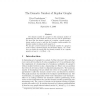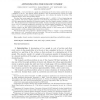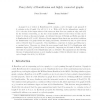16 search results - page 2 / 4 » On the domination number of Hamiltonian graphs with minimum ... |
ARSCOM
2004
13 years 5 months ago
2004
The domatic number of a graph G is the maximum number of dominating sets into which the vertex set of G can be partitioned. We show that the domatic number of a random r-regular g...
JCO
2007
13 years 5 months ago
2007
In a graph G, a vertex dominates itself and its neighbors. A subset S ⊆ V (G) is an m-tuple dominating set if S dominates every vertex of G at least m times, and an m-dominating...
SIAMCOMP
2002
13 years 5 months ago
2002
A set of vertices in a graph is a dominating set if every vertex outside the set has a neighbor in the set. The domatic number problem is that of partitioning the vertices of a gra...
JCT
2010
13 years 4 months ago
2010
A graph G on n vertices is Hamiltonian if it contains a cycle of length n and pancyclic if it contains cycles of length for all 3 ≤ ≤ n. Write α(G) for the independence numbe...
FCS
2009
13 years 3 months ago
2009
A set S V is a dominating set of a graph G = (V; E) if each vertex in V is either in S or is adjacent to a vertex in S. A vertex is said to dominate itself and all its neighbors. ...



